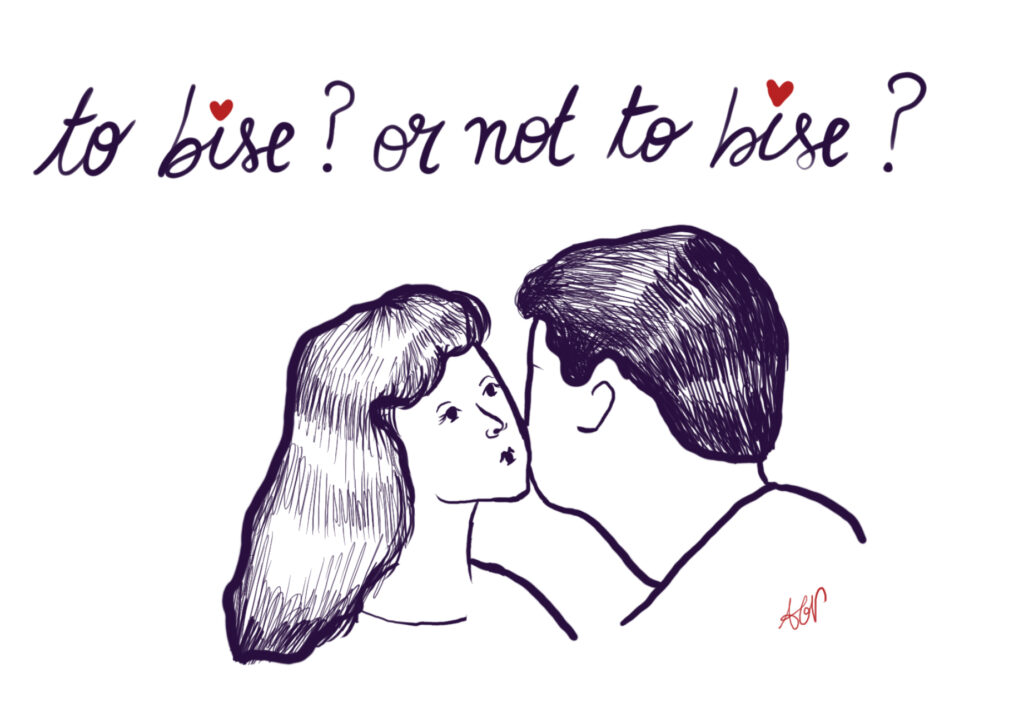
As an American born and raised in Los Angeles, I grew up in a world where hugs were the go-to greeting. Whether it was with a friend, my grandma, or even a complete stranger, a hug always seemed like the perfect way to initiate a conversation. That was until I ventured to France, where I discovered an entirely different social custom: la bise.
Everywhere I went, I saw people, both young and old, exchanging la bise—a gesture I had only seen in American movies or TV shows about France, where French culture is highly stereotyped. To me, la bise was something created by Americans to exaggerate French culture, but when I arrived in Reims, I learned the hard way that this was not the case. Most of my encounters with French people went like this: we would say, “Salut!” and then they would lean in, which I would mistakenly interpret as the start of a hug. In my true American fashion, I began to hug them back, only to suddenly feel a kiss on my cheek, followed by a polite “Mwah.”
That’s when it hit me—la bise was not just a charming French myth. It was a full-on cultural phenomenon that I had accidentally hugged my way right through. In my embarrassment, I would say, “Sorry, I’m American! I thought we were hugging!” to which my French counterpart would awkwardly say, “Yeah, I assumed that,” with a chuckle that deepened my shame.
Unlike a hug, la bise has many components that make it a challenge for foreigners to successfully accomplish. Where do you put your hands? How far apart do you stand? Which side do you start on? Do you make a kissing noise? Is it a real kiss or an air kiss? The questions are truly endless.
Something I recently learned further complicated my limited understanding of this charming but strange practice: depending on where you find yourself in France, the number of kisses differs. While the norm is two kisses, typically starting on the left side, some regions start on the right side and do one, three, or even four kisses! Personally, I find it quite excessive for a country smaller than the state of Texas to have that many variations in their greeting. I guess the Americans were right about how extra French people can be.
Sometimes, though, less is more. Other countries’ physical greetings, while sometimes strange to the foreign eye, are much simpler in reality. From sticking out your tongue in Tibet, to shaking hands in Botswana, China, or Germany, to clapping your hands in Zimbabwe or Mozambique, to bowing in Japan, these greetings are straightforward and can be used with anyone.
La bise, on the contrary, has specific rules and is appropriate in certain contexts but not in others. Generally, it is used to greet friends and family; however, I’ve also had moments where complete strangers leaned in for la bise, catching me off guard. I still cannot grasp how such an intimate gesture like la bise can be used with strangers. A hug, in my opinion, strikes the perfect balance—it’s warm and friendly, but doesn’t feel as personal as kissing someone on the cheek, making it less awkward when meeting someone for the first time. The forced “mwah” noise can also be quite unnerving, as it is not always clear whether it should be reciprocated, at what volume, and when. These unclear social rules of la bise add to the complexities of navigating it, leaving many newcomers feeling lost in translation.
While this cheek-kissing custom may seem intrinsically French, it actually originated in Ancient Rome and spread throughout the various territories of the Roman Empire, including France. Ironically, la bise of antiquity was put on pause in the fourteenth century to prevent the spread of the plague. Yet, hundreds of years later, France continues to practice a social code that was nearly wiped out by disease. Maybe the French should take a lesson from the Japanese and adopt the contactless bow. With all the confusion around la bise, I sometimes think the French just enjoy watching foreigners struggle to navigate their complicated social rituals. Why complicate things in a world already filled with complexities? As a foreigner trying to navigate these intricate customs, I often wonder if a simple universal wave might be the best way to bridge the cultural gap.
Other posts that may interest you:
Discover more from The Sundial Press
Subscribe to get the latest posts sent to your email.





